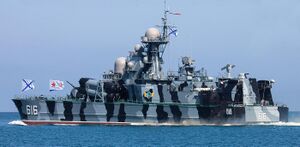Engineering:Bora-class hovercraft
 Samum.
| |
| Class overview | |
|---|---|
| Builders: |
|
| Operators: |
|
| Built: | 1988–1995 |
| In commission: | 1997-present |
| Completed: | 2 |
| General characteristics | |
| Displacement: | Around 1,050 tonnes (1,030 long tons) |
| Length: | 215 ft (66 m) |
| Beam: | 56 ft (17 m) |
| Draught: | 10 ft (3.0 m) |
| Installed power: | 4 × 200 kW diesel-driven generators |
| Propulsion: |
|
| Speed: |
|
| Range: |
|
| Endurance: | 10 days |
| Complement: |
|
| Sensors and processing systems: |
|
| Electronic warfare & decoys: |
|
| Armament: |
|
| Notes: | Combat ready in rough weather up to Sea State 5 |
The Bora-class hoverborne guided missile corvette of the Russian Navy, also bears the NATO class name Dergach, is one of the few types of military surface effect ship built solely for marine combat purposes, rather than troop landing or transport. Its designation in the Soviet and Russian navies is Project 1239; the first vessel produced under this designation was Sivuch, which was later renamed Bora. It is one of the largest combat sea vehicles with catamaran design.
The ship is one of many marine craft built by the Russian Federation for coastal defense, both domestically and for export. The weapons array Bora class warships carry varies depending on which of several configurations it is built to. The specifications listed are for the two existing craft.
Deployment
The Bora-class was designed in 1988 mainly for coastal defense and patrol duties against surface vessels, large and small. Two were built and are currently in service, both assigned to the Russian Black Sea Fleet. A future series of hovercraft have been planned based on this model for future production.
Ships
| Name | Hull No. | Laid down | Launched | Commissioned | Fleet | Status | Notes |
|---|---|---|---|---|---|---|---|
| Bora (ex-Sivuch) |
615 | 1988 | 1997 | Black Sea Fleet | Active | ||
| Samum | 616 | 1995 | 2000 | Black Sea Fleet | Active |
See also
- List of ships of the Soviet Navy
- List of ships of Russia by project number
References
- Missile hovercraft, project 1239. Zelenodolsk Shipyard.
- Rosoboronexport State Export Corporation Website, Navy Catalog (PDF Format) - Various export configurations are listed in this catalog. Follow the link and click the "PROJECT 1239 BORA" link on the third page of the pdf.
- Guided Missile Corvette "Bora" from Russian Black Sea fleet (with 48 photos)
- Guided Missile Corvette "Samum" from Russian Black Sea fleet (with 30 photos)
- [1]
- [2]
- Google Maps photo
- (in English) All Russian Bora Class Ships - Complete Ship List

